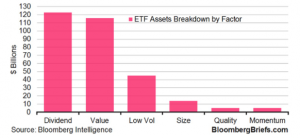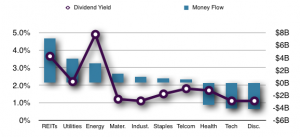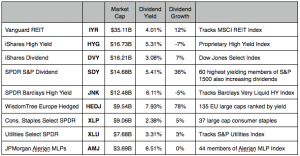Cash Cow
4 Stellar Income Funds
- Income funds attract more capital than Value for the first time ever
- 9 ETFs have attracted the lions’s share of new money flowing into the asset class
- REITs, Utilities and Energy rank highest among sectors for both dividend yield and net inflows
- Yellen’s Jackson Hole mention of sub-2% inflation for several years extends yield grab
BlackRock CEO Larry Fink must absolutely love Fed Chair Janet Yellen. Her classic Greenspan doublespeak is very good for his top-ranked ETF business. While telling us “The case for rate increases has improved in recent months,” she also made clear in her Jackson Hole speech last week inflation will “stay below 2% for several years.” In other words, the economy is improving, but it’s hardly a runaway train. So forget about trying to pick growth stocks, just park your money in steady-eddie income funds. BlackRock’s iShares business now accounts for 23.5% of the firm’s assets under management, and with Yellen’s implicit endorsement for the passive money crowd, I could imaging Mr. Fink embracing a new fall ad campaign… #StashYourCash followed by #ThankYouJanet.
To be clear, Chair Yellen isn’t really saying anything new. The dual mantra of Low Rates and Sub-par Growth has created a stampede into income funds this year which gives the Houston Rodeo a run for its money. The total amount of capital flowing into income-related ETFs has outpaced flows into value-focused funds this year for the first time ever. Instead of betting on capital appreciation tomorrow, investors are opting for cash returns today.
Cash Is King

What’s particularly revealing from Bloomberg’s data is the lack of interest in “Quality” or “Size” as a determinant for what to buy. This is presumably because large, AAA-rated companies currently trade at premium valuations, which implies they generally yield less than 2% and their bonds offer piddles in the way of return. By contrast, the junk bond ETF JNK has seen shares outstanding rise 20% this year, and the emerging markets ETF EEM has seen a 28% increase in assets just since June. Investors are eschewing all definitions of safety in search of yield.
You can also see this move farther out the risk spectrum when comparing fund flows by sector. ETFs which invest in REITs have attracted $7.1B in capital this year, by far the largest net inflow. Never mind developers are paying record low 3 to 4% cap rates, pushing breakeven holding periods on commercial properties to 30 years. As long as buildings generate cash flow, banks will fund the debt and pension funds will buy the equity… their underfunded obligations mean they need cash NOW. Utilities too have become the darlings of income investors this year. Again, never mind they trade at 18 times forward earnings and require regulatory approval to raise rates even 1%. Investors want income, and income hard to find.
Chasing Income
ETF Flows by Sector YTD

You can see the clear correlation between higher yield (purple line and left-hand scale) and where the money is flowing (blue bars and right-hand scale). As for specific funds these nine have grabbed the lion’s share of income seeking capital.
Income Stampede
The Herd’s Favorite ETFs

I hate crowded trades, but I also recognize Chair Yellen is telling us to expect relatively low rates for the next several years, which means income will remain crucial to generating total return. Like it or not, we have to own some of these funds, or at least the stocks they hold in position. I offer four suggestions:
1. SPDR Select Dividend ETF (SDY)
Of the ETFs cited above, I particularly like the methodology of the SPDR Select Dividend ETF (SDY). It choses the 60 highest yielding stocks in the S&P 1500 Index which have also raised dividends consistently every year for 20 years. The fund holds a total of 108 equities across multiple sectors. Indicated yield (next dividend annualized) is 2.37%, but each December it announces a capital gain which bumps yield significantly –figure 5.4% this year based on last year’s payout. In addition, Bloomberg currently forecasts an increase in the September dividend to $0.57, 12% above the June level.
2. JPMorgan Alerian MLP Fund (AMJ)
I reiterate my fondness for the JPMorgan Alerian MLP Fund (AMJ), which invests in the toll-collecting components of energy infrastructure and pays a generous 6.5% dividend. I just wrote it up last at the beginning of August so I should probably “cool it” on this theme, but I really do believe it makes excellent sense. As long as energy products are moving (which is always) pipeline companies make money and distribute cash flow to investors. In a related vain, one of our subscribers emailed me the following response after I wrote the AMJ piece: In your search for oil plays look at The Cushing Total Return Fund (SRV), a closed end fund (no paperwork) of MLPs. It’s all pipelines selling at a 15% discount to NAV and yielding 8-9%. The fund sold at a premium in the good old days, though it’s thin. Thanks EH.
3. Vanguard’sWellington Fund (VWELX)
My good friend and former guest from Bloomberg Television, Dan Weiner also happens to be THE GURU for all things Vanguard. His monthly Independent Advisor for Vanguard Investors is followed by tens of thousands. He describes the flagship Wellington Fund (VWELX) as “The grand-daddy of the mutual fund industry and it’s still going strong… run by a pair of Wellington Management veterans in very steady fashion.” The managers invest about two-thirds of capital in high-quality blue chips and the balance in a combination of “top-notch” government and corporate bonds. The current indicated yield is 2.59%, but that will likely rise to about 6% when the annual year-end distribution is announced in December. This is a fund for the buy and hold crowd. It charges a management fee of 0.24% and has expense ratio of 0.26%.
4. InfraCap Active MLP ETF (AMZA)
If you feel like a walk on the wild side, check out the “impossibly” high yielding InfraCap Active MLP ETF (AMZA). The operative word is here active. It currently yields 18.06%, in spite of holding 34 MLPs which yield a maximum of 10.57%. The fund does not use leverage. So how do they do it you ask? By writing options, LOTS of options. Most are covered calls, meaning there is a long position match against the short call. But my recent podcast cast guest, Investor Media Managing Editor Kyle Woodley did some digging and unearthed a spreadsheet of current holdings. To be clear, there’s nothing wrong with writing out-of-the-money options which go to zero in order to capture premium. Just recognize it’s all well until it isn’t. I actually kinda like this strategy, but I may have to just watch it for a while before I dive in.
Subscribe at https://bullseyebrief.com

